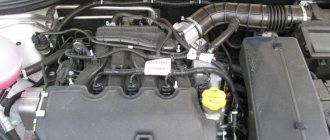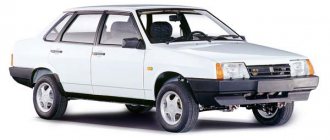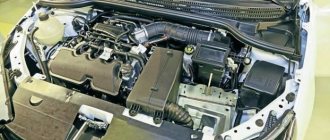Lada Largus is a Russian car built on the basis of the first generation Renault Logan MCV minivan. Initially, this model was called Dacia Logan, and was sold since 2006 in Romania. Production of the Russian modification began in 2011. Since then, the car has been produced virtually unchanged. However, unlike the original foreign car, Largus has several body versions. Thus, not only a minivan is available for sale, but also a commercial van, as well as an all-terrain version of the Largus Cross. In Russia, Lada Largus is considered the best-selling family car. The top-end version of the Lada Largus seats seven passengers and is also equipped with modern equipment and the ERA-GLONASS emergency warning system.
Owner reviews. Engine 16l 106l 21129
The previous owner beat it up pretty badly, the engine was completely destroyed, the fuel consumption rate did not fit within any limits, besides, the engine ate oil, the exhaust gases had a pronounced black color. Based on these data, we can judge that the K4M engine turned out to be more modern and its efficiency is higher than that of the other two engines that are equipped with the Lada Largus, but we can judge the real numbers based on reviews from the owners of this car.
| Model | Consumption (highway) | Consumption (city) | Consumption (mixed cycle) |
| Lada Largus | 6.7 l/100 km | 10.6 l/100 km | 8.2 l/100 km |
CNG filling station infrastructure
Fuel consumption calculator: calculate fuel consumption
Before the trip, this question seemed to us one of the most important. Now we consider it the most important. The car can be used within the city without any doubt. In Tolyatti, for example, where there are only two methane gas stations for a city of seven hundred thousand, this will generally cause moderate inconvenience. But when traveling around Russia everything is even worse. Our route was compiled taking into account the infrastructure of CNG filling stations, which are located in Togliatti, Syzran, Penza, Ryazan, Tula, Kaluga and Smolensk. That is why we were forced to deviate from the shortest route and drive into the city.
To obtain up-to-date information, we used the website AGNKS.RU, where up-to-date user information on all methane gas stations in Russia is collected in map format.
To obtain up-to-date information, we used the website AGNKS.RU, where up-to-date user information on all methane gas stations in Russia is collected in map format.
In some cities, we could choose from two gas stations, making it more comfortable to plot our route in the navigator. Theoretically, we could cover the entire route using methane. But one of the tasks was to find out what the real power reserve is on one cylinder. So we flew through the first refueling in Syzran (only a few hundred meters from the M5 highway) “in full sail” and assumed that there would be enough methane to reach Penza (the path from Tolyatti to Penza is 350 km). Not enough.
Tuning the Largus engine and other models with engine 21129: Engine 16l 106ls 21129
| Consumption table for VAZ engines As for fuel consumption, I can say that gasoline consumption is acceptable, of course the car consumes a lot at high speeds, but on the highway everything changes for the better. Below we present the characteristics of the most popular models, and in the tables below them the average fuel consumption of a Lada car per 100 km is based on A-95 gasoline, the unit of measurement is liter when driving in the urban cycle, outside the city and in the mixed cycle. |
- K7M - 8-valve engine with 84 hp. pp., which is produced at the Automobile Dacia plant (Romania) of the Renault concern.
- K4M - 16-valve power unit with a capacity of 105 hp. pp., manufactured at the Renault Espana plant; The K4M power unit is also assembled at AvtoVAZ OJSC. In terms of ecology, it now complies with EURO-5 standards, but at the same time it has lost a little in power (102 hp) and torque (145 Nm).
- VAZ-11189 is a domestic 8-valve engine with a power of 87 hp. With.
Lada Xray
The first crossover to roll off the assembly lines of the Togliatti automobile plant was the Lada X-ray model. The presentation of the car took place at the Moscow Auto Show in 2012, and mass production of the new model began in 2015. The car is produced with 1.6-liter gasoline engines and a power of up to 110 hp. and equipped with a mechanical transmission.
In the near future, versions of the Lada Xray Cross with a 1.8 liter 16-valve power unit with a capacity of 122 hp should appear on sale. The Crosses are equipped with a five-speed manual transmission, but an automatic transmission can be installed at the client’s request. In addition, AvtoVAZ announced the release of X-ray “Sport” with engines of 16 valves and 1.8 liters in volume, developing a power of 145 “horses”.
Both new versions should feature qualitatively new suspensions.
| Engine | Consumption (city) | Consumption (highway) | Flow (mixed) | Type of fuel |
| 1.6 MT 106 hp (Mechanics) | 9.3 | 5.9 | 7.2 | Petrol |
| 1.6 MT 110 hp (Mechanics) | 8.9 | 5.6 | 6.8 | |
| 1.8 MT 122 hp (Mechanics) | 9.3 | 5.8 | 7.1 | |
| 1.8 AMT 122 hp (robot) | 8.6 | 5.8 | 6.8 |
New generation Lada
The presentation of Lada Largus, which is a joint project of VAZ and Renault, took place in 2011. The purpose of inventing this version of the Lada was to make the 2006 Dacia Logan similar to the Romanian car, suitable for Russian roads.
| Model | Consumption (highway) | Consumption (city) | Consumption (mixed cycle) |
| Lada Largus | 6.7 l/100 km | 10.6 l/100 km | 8.2 l/100 km |
Technical characteristics of the Lada Largus, fuel consumption and maximum speed for all models are almost the same
. The main configuration parameters include:
- Front-wheel drive;
- 1.6 liter engine;
- 5-speed manual transmission;
- The fuel used is gasoline;
Each car has an 8- and 16-valve engine, except for the Cross version. It is equipped only with a 16-valve engine. The maximum speed of the car is 156 km/h (with engine power of 84, 87 horsepower) and 165 km/h (engine with 102 and 105 horsepower). Acceleration to 100 kilometers is carried out in 14.5 and 13.5 seconds, respectively. The average fuel consumption of Largus per 100 km in the combined cycle is 8 liters.
Lada Kalina
The first Kalin prototypes appeared back in 1999, but serial production of these models began only in 2004. Initially, the car was produced in a sedan body, but later hatchbacks and station wagons were added to them. The cars were equipped with power units with volumes of 1.4 and 1.6 liters. The first made it possible to develop a power of 89 hp, the second - 81 hp. in the eight-valve version and 98 hp. in a sixteen-valve First generation cars have an exclusively manual transmission.
Reviews about the Lada Largus 1.6 liter engine. 16th grade
If we compare the consumption of a car with a K7M engine, then the station wagon has the lowest fuel consumption per 100 km; on average, gasoline savings are about 500 grams. The only unpleasant thing is the real consumption of the Lada Largus, after a hundred thousand mileage it increased and began to hit my pocket, at the moment, to be calm, I fill up with gasoline at the rate of 14-15 liters per hundred kilometers of road.
What factors influence the increase in gasoline costs?
The efficiency of cars of the Lada Largus family is influenced by:
- technical condition of the chassis and transmission;
- weight of cargo or number of passengers in the cabin;
- road profile and congestion;
- management style;
- condition of gasoline injection nozzles and catalytic converter;
- average speed;
- air temperature and road surface condition;
- frequency of air conditioner use.
Efficiency is affected by the degree of grinding in of engine and transmission parts. The plant allows increased fuel consumption during the first 10-12 thousand km; after scheduled maintenance, consumption stabilizes.
Owner reviews: 11189 VAZ 16 liter engine
| Lada Largus and fuel consumption per 100 km: passport, real data From 1997 to 2000, AvtoVAZ produces for experimental operation an updated VAZ 2115 model with a carburetor, a 1.5 liter engine and a power of 72 hp. To objectively assess the gasoline consumption of both engine modifications, it is necessary to compare factory indicators with real reviews from owners of the Lada Largus family station wagon. |
| Lada Largus cross engine VAZ 21129 reviews In order to determine the real fuel consumption when operating the LADA Largus in highway conditions, you need to constantly monitor its speed. The basic fuel consumption rate of the Lada Largus on the highway is 7.5 liters, city driving consumes 11.5 liters, and mixed driving consumes 9 liters per 100 km. |
- Hello. I bought a Lada Largus last year from Elex Polyus under a loan program. First impressions were very good. At the moment the car has covered 2,500 thousand, it seems to have become faster. pros: stable, more than 140 km.
Fuel consumption of Lada Granta • Under the hood of a modern Russian design there are two modest 1.6-liter engines.
Table of fuel costs for VAZ brands.
The table describes the average costs for different VAZ brands . Fuel consumption is presented in three types - city, highway and mixed (average) fuel consumption. All data on fuel costs are from the VAZ car manufacturer. For almost all brands of VAZ cars, fuel consumption does not exceed 10 liters per 100 km, with the exception of the carburetor Niva.
Average fuel consumption VAZ
liter/100 km
| Brand VAZ | Power, hp | City | Route | |
| VAZ 2101 (1.2, carburetor) | — | 10.5 | 11 | |
| VAZ 2102, 2103 (1.5, Carburetor) | 71 | 11 | 11.5 | |
| 2106 (1.57 engine, carburetor, four-speed gearbox) | 76.4 | 9.5 | 10.5 | 8.5 |
| 2106 (1.45 engine, carburetor, four-speed gearbox) | 73.5 | 9.9 | 10.8 | 9.0 |
| 2106 (engine 1.6, injector) | — | 8.4 | 9.8 | 7 |
| 2105 (1.3, carburetor) | 64 | 9.1 | 10.2 | 8.1 |
| 2105 (1.5, carburetor, four-speed gearbox) | 71.1 | 8.8 | 9.5 | 8.0 |
| 2107 (1.6, injector) | — | 7.8-9.8 | 9-11.5 | 6.7-8.2 |
| 2107 (1.6, carburetor) | — | 8.9 | 10.2 | 7.5 |
| 2107 (1.5, carburetor) | — | 8.3 | 9.6 | 7.0 |
| 2108, 2109, 21099 (1.5, carburetor) | 72 | 9.1 | 10.1 | 8.2 |
| 21083, 21093, (1.5, injector) | 72 | 7.6 | 8.5 | 6.7 |
| 2110, 2111, 2112 (1.5, carburetor) | 67.7 | 9.5 | 10.5 | 8.4 |
| 2110, 2111, 21124 (1.5, injector) | 72 | 7.9 | 8.7 | 7.0 |
| 2113, 2114, 2115 (1.5, injector) | 72 | 7.6 | 8.5 | 6.7 |
| Lada Granta (8 valve) | 80 | 7.0 | 8.3 | 5.8 |
| Lada Granta (8 valve) | 90 | 7.7 | 9.3 | 6.1 |
| Lada Granta (16 valve) | 98, 106, 120 | 8.1-10.1 | 9.2-11.2 | 7-9 |
| Lada Kalina 21117, 21118, 21119 (1.4 engine) | — | 6.9 | 7.8 | 6.0 |
| Lada Kalina 21118, 21119 (engine 1.6) | — | 7.2 | 8.1 | 6.3 |
| Lada Priora (1.6) | 90 | 7.6 | 8.8 | 6.5 |
| Lada Priora (1.6, 16 valve) | 106 | 8.6 | 9.5 | 7.7 |
| Lada Vesta 21179 (1.8, 16 valve) | 123 | 8.5-10.5 | 9.5-11.5 | 7.5-9.5 |
| Lada Vesta 21129 (1.6, 16 valve) | 106 | 8-10 | 9.0-11.0 | 7.0-9.0 |
| Lada x-Ray (X-ray, 1.6, 16 valves) | 110 | 7.9 | 8.8 | 7.0 |
| Lada x-Ray (X-ray, 1.8, 16 valves) | 122 | 8.1 | 9.1 | 7.2 |
| Lada Largus (1.6, 8 valve) | 90 | 8.6 | 9.5 | 7.7 |
| Lada Largus (1.6, 16 valve) | 105 | 8.2 | 9.0 | 7.5 |
| VAZ 21213 (Niva, 1.7, carburetor) | — | 11.5 | 13.0 | 10.0 |
| VAZ 21214 (Niva, 1.7, injector) | — | 9.8 | 11.0 | 8.5 |
| VAZ 2131 (Niva, 1.8, injector) | — | 11.1 | 12.8 | 9.5 |
Lada Granta
The Lada Granta model replaced the Kalina, which did not generate huge demand among consumers. In this modification, the creators of the car took into account the requirements of customers and developed several options for appearance and configuration. Since 2011, the model has been produced in a sedan body, and a little later a liftback version appeared on the market.
As a rule, Granta is equipped with a power unit of 1.6 liters in volume. The 8-valve version of the engine is capable of producing 87 hp, and is paired with either a five-speed manual transmission or a four-speed automatic. The 16-valve modification of the engine produces 106 hp. and is equipped with the same boxes.
The Lada Granta has a special “Sport” modification with a 116 hp engine. and with a manual five-speed gearbox.
| Engine | Consumption (city) | Consumption (highway) | Flow (mixed) | Type of fuel |
| 1.6 MT 82 hp (Mechanics) | 9.7 | 6.1 | 7.4 | Petrol |
| 1.6 MT 87 hp (Mechanics) | 9.0 | 5.8 | 7.0 | |
| 1.6 AT 87 hp (machine) | 10.4 | 6.1 | 7,7 | |
| 1.6 MT 98 hp (Mechanics) | 8.8 | 5.6 | 6.8 | |
| 1.6 AT 98 hp (machine) | 9.9 | 6.1 | 7.6 | |
| 1.6 MT 106 hp (Mechanics) | 8.6 | 5.6 | 6.7 | |
| 1.6 AMT 106 hp (robot) | 9.0 | 5.2 | 6.6 |
Reviews from car owners
Thus, the car on different sections of the highway moves at different speeds from 40 to 130 km per hour, and the average speed of a car such as LADA Largus does not exceed 77 km per hour. Fuel consumption in any car depends on a number of subjective and objective factors, ranging from traffic congestion, the number of traffic lights along the way and the time of year, to driving style.
Factors increasing gasoline costs
The main reasons for consuming more fuel are:
- Engine fuel consumption often increases due to low-quality fuel. This happens if you had to use the services of unverified gas stations or “filling up” with gasoline with a lower octane number.
- An important point is the use of additional electrical equipment or unnecessary track lighting. They promote the combustion of large quantities of gasoline in a short time.
- The driving style of the car owner is considered the main factor that affects the gasoline consumption of Lada Largus of all models. To avoid such problems, you need to drive smoothly and brake slowly.
Fuel consumption of Lada cars. With VAZ-21127 engine 16 106 l s
| Engine 21129 Lada X Rey, Largus: Resource reliability An air filter clogged with dust has increased resistance to the air flow entering the engine, as a result of which engine power decreases and fuel consumption increases. The basic fuel consumption rate of the Lada Largus on the highway is 7.5 liters, city driving consumes 11.5 liters, and mixed driving consumes 9 liters per 100 km. |
- The model of car;
- engine capacity;
- aerodynamic performance;
- technical serviceability (condition of the engine, spark plugs, injector, filters, etc.);
- type of fuel (gasoline, diesel, gas);
- time of year (in winter these indicators are higher than in summer);
- driver's driving style;
- place of operation (driving outside the city is more economical than within its boundaries);
- condition of the roadway;
- weather.
Expert recommendations • In addition, engineers managed to get rid of the mass air flow sensor.
Fuel and lubricant consumption standards 2022: correction factors
It is advisable to separately approve summer and winter fuel consumption standards. In addition, the limit may depend on the population in the region where the machine will be operated. The necessary correction factors can also be approved by order of the organization.
An order for approval of correction factors may look like this:
If a company exceeds the established limits and cannot document the validity of this excess, then the costs of fuel and lubricants in excess of the standards established by it cannot be taken into account when calculating income tax.
In this case, exceeding the limit costs for fuels and lubricants will not be economically justified.
Additional useful information about Lada fuel consumption
Station wagons do not have impressive speed characteristics. True, Renault in versions with the most powerful power units has a slightly better figure than Lada. But despite this, cars are more designed for calm drivers. At the same time, they are fuel efficient. And the Russian bi-fuel version is a super economical option for those who travel a lot and are not ready to pay a lot of money for gasoline.
Design features of engines on Lada Vesta
Models are equipped with one of three types of gasoline engines:
- VAZ 21116 (1.6 / 8 cl. / 87 hp);
- VAZ 21127 (1.6 / 16 cl. / 106 hp);
- Renault-Nissan HR16DE-H4M (1.6 / 16 cl. / 114 hp).
The first two modifications are domestically produced with a volume of 1.6 / 1.8 liters and a power reserve of 106 hp. valves are bent. The third model is an imported development by French engineers, where a chain is installed instead of a belt drive, and as a result, there is no bending of the valves.
The reason why the valve heel is bent is due to insufficient depth of the recess on the piston surface. For unknown reasons, the engineers “didn’t finish” a few missing millimeters. When the belt drive breaks, the valve heels hit the surface of the piston, and the metal at the point of contact is deformed.
Lada Priora
When promoting the Lada Priora to the market, the manufacturer positioned it as a family car with a low cost. This model has been on sale since 2007. Priora has several body styles: sedan, station wagon, hatchback. The latter is produced in two modifications: with five doors and with three.
In 2013, the manufacturer made minor changes to the appearance of this Lada model and made the engines more powerful. The Priora is equipped with one of two petrol power units: either a 1.6 liter engine (the simplest has 8 valves and a power rating of 87 hp, and the most complex has 16 valves and 106 “horses”), or with a volume of 1.8 liters and with a capacity of 123 “horses”.
| Engine | Consumption (city) | Consumption (highway) | Flow (mixed) | Type of fuel |
| 1.6 MT 81 hp (Mechanics) | 9.8 | 5.6 | 7.6 | Petrol |
| 1.6 MT 98 hp (Mechanics) | 9.8 | 5.6 | 7.2 | |
| 1.6 MT 106 hp (Mechanics) | 8.9 | 5.6 | 6.8 | |
| 1.6 AMT 106 hp (robot) | 8.5 | 5.5 | 6.6 | |
| 1.8 MT 123 hp (Mechanics) | 9.8 | 5.6 | 7.2 |
Passport data on gasoline consumption of a Lada Largus car
Despite the large volume of clinical tests that all cars undergo before being placed on the market, the gasoline consumption of the Lada Largus presented in the technical data sheet may differ significantly from the actual figures. The Lada Largus car has several modifications: passenger R90 station wagon for 5 and 7 seats, cargo van F90 and all-terrain station wagon Lada Largus Cross.
Prices and payback
Today, the production volumes of the dual-fuel versions of Vesta and Largus are approximately the same, ranging from 160 to 200 cars per month.
Now Lada Largus CNG is presented in three versions - a van, a station wagon (5 seats) and a cross version (5 seats).
Now Lada Largus CNG is presented in three versions - a van, a station wagon (5 seats) and a cross version (5 seats).
The bi-fuel Largus costs about 70,000 rubles more than the gasoline version.
The bi-fuel Largus costs about 70,000 rubles more than the gasoline version.
In the van version, the cylinder is located behind the front wall of the luggage compartment, only slightly limiting access through the side doors.
In the van version, the cylinder is located behind the front wall of the luggage compartment, only slightly limiting access through the side doors.
Standard • Engine 16l 106l 21129
I bought a 2011 car, just off the assembly line, and I don’t regret anything, parts are always available in any store, although breakdowns do not happen often if the main components are serviced in a timely manner. Just like the previous power unit, this engine is paired with a 5-speed manual gearbox and can accelerate the car to a maximum speed of 155 km/h.
| № | Positive |
| 1 | Andrey (Avtodrom): I’ve been driving carefully for three years now and systematically carry out maintenance. I heard about the valve problem. I think that a lot depends on the driver. |
| 2 | Sergey (Avtotema): I have a 16-valve engine, the pickup from the bottom is weak, but on the highway the engine is a “beast”, I have no complaints about the internal combustion engine, I’m happy with the purchase. |
| 3 | Kirill (Autoreview): the engine has driven 65,000 km and is normal; at every service I carry out diagnostics. |
| 4 | Alexey (Avtoria): unlike Granta, Vesta is more powerful, with a good pick-up. I'm glad for the domestic manufacturer. |
| 5 | Alexander (Drom): my positive review of the VAZ 21116, four years of active use without any comments. |
| 6 | Stanislav (Driving): I have no problems with the car, the mechanisms are working normally. |
| 7 | Vasily Alekseevich (“5th wheel”): at 50,000 km the alternator belt began to whistle, tightened it. The valves do not knock, the engine runs smoothly. |
| Negative | |
| 8 | Vitaly (Avtotema): recently the belt drive broke, fortunately it reacted with lightning speed, the valves were not damaged. |
| 9 | Svyatoslav (Otzovik.net): when they broke, the first and third pistons were deformed, replaced them with new ones. The repairs weren't cheap. |
| 10 | Vlad (ProAuto): I regret that I bought Vesta with a domestic engine, my comrades advised me to buy it with a Renault engine. |
Fuel consumption for 8-valve models - With VAZ-21127 engine 16,106 l s
| Fuel consumption of the Lada Largus per 100 km: engine 1.6 8 and 16 valves Lada car manufacturers are trying to keep up with the times and are making a lot of efforts to reduce the fuel consumption of their products and make the costs of their operation affordable to ordinary motorists . In this case, a rapid increase in engine speed is formed; for this, the maximum amount of the explosive mixture must enter the cylinders in a short time. |
| Fuel consumption on a Largus 16 valve In general, the station wagon's fuel consumption is quite good, with excellent technical characteristics of the car and a fairly attractive price. When purchasing, I had a choice between an inexpensive domestic, but new car or a German analogue with mileage in Europe, but at the last moment I settled on the Lada Largus and although the fuel consumption rate is higher than that of the European analogue, it is much cheaper to maintain. |
- the valve mechanism must be adjusted at intervals of 45,000 km;
- the oil filter needs to be changed more often than other models (10,000 km);
- rapid wear of the cooling system elements occurs;
- Frequent engine oil leaks occur due to depressurization of sealing gaskets;
- The clamping nuts on the exhaust exhaust pipe burst and need to be replaced with brass ones.
How to drain fuel from the system
In order to drain the fuel or change the fuel pump of the Lada Largus, you need to know the structure of the gasoline supply system. The Largus fuel system begins with the gas tank, through which we refuel the car at the gas station, and continues with main hoses to the engine inlet valves. But the gas tank cap is not the only access to the 50-liter container containing the fuel. Another tank hole is hidden under the rear seats of the car.
Having removed the rear sofa, we see a plastic cover. To remove it, you need to pry it with a screwdriver in the direction of the arrow. Under it there is a plastic lock nut with two connectors, one of which is removed using an awl, and the second by pressing on both sides. Remove the nut with a gas wrench or other wrench. In no case should you knock the nut with a chisel, this will make it difficult to install it in place.
After removing the nut we have access to the fuel pump. Then it is possible to replace the pump, fuel filter and other elements. After removing the fuel pump, direct access to the tank is created. If unsuitable fuel or foreign elements enter the gas tank, the mixture from the main tank must be drained.
How to drain gasoline from a gas tank? It is necessary to drain using a hose into a container located below the level of the gas tank (best of all - in an inspection hole). The hose should be kept at an angle to the bottom of the tank for better suction. In this way, you can drain the entire volume of the tank in a short period of time (25–30 minutes).











